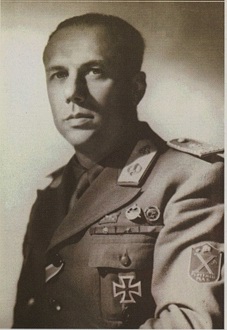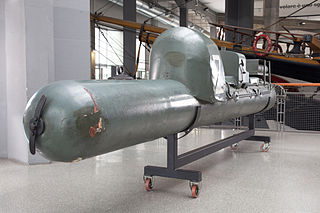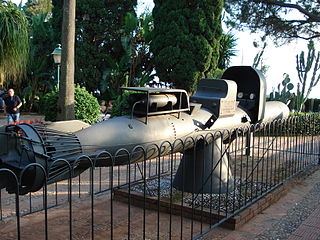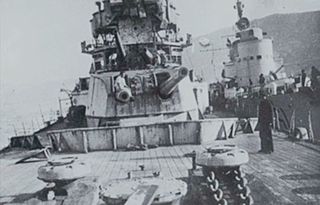
A frogman is someone who is trained in scuba diving or swimming underwater in a tactical capacity that includes military, and in some European countries, police work. Such personnel are also known by the more formal names of combat diver, combatant diver, or combat swimmer. The word frogman first arose in the stage name the "Fearless Frogman" of Paul Boyton in the 1870s and later was claimed by John Spence, an enlisted member of the U.S. Navy and member of the OSS Maritime Unit, to have been applied to him while he was training in a green waterproof suit.

Junio Valerio Scipione Ghezzo Marcantonio Maria Borghese, nicknamed The Black Prince, was an Italian Navy commander during the regime of Benito Mussolini's National Fascist Party and a prominent hardline neo-fascist politician in post-war Italy. In 1970, he took part in the planning of a neo-fascist coup, dubbed the Golpe Borghese, that was called off after the press discovered it; he subsequently fled to Spain and spent the last years of his life there.

Human torpedoes or manned torpedoes are a type of diver propulsion vehicle on which the diver rides, generally in a seated position behind a fairing. They were used as secret naval weapons in World War II. The basic concept is still in use.

The Decima Flottiglia MAS was an Italian flotilla, with marines and commando frogman unit, of the Regia Marina. The acronym MAS also refers to various light torpedo boats used by the Regia Marina during World War I and World War II.

Italian submarine Iride was a Perla-class submarine built for the Royal Italian Navy during the 1930s. Originally, she was named Iris until July 1936, but was renamed shortly before her launch.

Marquis Luigi Durand de la Penne was an Italian Navy admiral who served as naval diver in the Decima MAS during World War II. He was born in Genoa, where he also died.

Britain's commando frogman force is now the Special Boat Service (SBS), whose members are drawn largely from the Royal Marines. They perform various operations on land as well as in the water. Until the late 1990s, all members of the Special Air Service (SAS) Boat Troop were trained as commando frogmen.

COMSUBIN is the Italian Navy's special operations unit. Italy was the first nation to use frogmen and human torpedoes. The Royal Italian Navy's Naval Assault Divisions are considered to be the precursor of modern Naval Special Forces. Their record can be traced back to World War I and the operation against the Austrian-Hungarian Battleship Viribus Unitis in Pula Harbour in 1918.

Teseo Tesei was an Italian naval officer, who invented the human torpedo used by the Regia Marina during World War II.
The Italian Co-Belligerent Navy, or Navy of the South or Royal Navy, was the navy of the Italian royalist forces fighting on the side of the Allies in southern Italy after the Allied armistice with Italy in September 1943. The Italian seamen fighting for this navy no longer fought for Italian dictator Benito Mussolini. Their allegiance was to King Victor Emmanuel and Marshal of Italy Pietro Badoglio, the men who ousted Mussolini. This culminated in the fall of fascism in the south of Italy.

The Raid on Alexandria was carried out on 19 December 1941 by Italian Navy divers of the Decima Flottiglia MAS, who attacked and sank two Royal Navy battleships at their moorings and damaged an oil tanker and a destroyer in the harbour of Alexandria, Egypt, using Siluro Lenta Corsa manned torpedoes.

The Raid on Souda Bay was an attack by the Decima MAS (X-MAS), a specialist unit of the Regia Marina that used unconventional weapons. Decima MAS used explosive boats (MTM) against British ships lying in Souda Bay, Crete, during the early hours of 26 March 1941. The MTM explosive boats had been ferried from Astypalaia by the destroyers Francesco Crispi and Quintino Sella and launched at the approaches to the bay. After crossing the three boom defences, the MTM attacked the British heavy cruiser HMS York and the Norwegian tanker Pericles (8,324 GRT).

The auxiliary ship Olterra was a 5,000 ton Italian tanker scuttled by her own crew at Algeciras in the Bay of Gibraltar on 10 June 1940, after the entry of Italy in World War II. She was recovered in 1942 by a special unit of the Decima Flottiglia MAS to be used as an undercover base for manned torpedoes in order to attack Allied shipping at Gibraltar.

The CB class was a group of midget submarines built for the Italian Navy during World War II. However, they were also used by several other navies, seeing action in the Mediterranean and in the Black Sea.

Spartaco Schergat was an Italian military frogman during World War II.

The explosive motorboat MT also known as barchino, was a series of small explosive motor boats developed by the Italian Royal Navy, which was based on its predecessors, the prototype boat MA and the MAT, an airborne prototype. Explosive motorboats were designed to make a silent approach to a moored warship, set a collision course and run into full gear until the last 200 or 100 yards to the target, when the pilot would eject after blocking the rudder. At impact, the hull would be broken amidships by a small explosive charge, sinking the boat and the warhead, which was fitted with a water-pressure fuse set to go off at a depth of one metre.

Mario Elbano Masciulli Manelli, Baron Miglianico was a prominent military engineer of the Italian Regia Marina, Major of Genio Navale and belonging to the recognized Decima Flottiglia MAS as director of the Office of Submarine Secret Weapons during Second World War. He was awarded the Silver Medal of Military Valor.

Mario Marino was an Italian sailor of the Regia Marina during World War Two. As a diver and human-torpedo operator with the Decima Flottiglia MAS, he won the Gold Medal of Military Valour for the Raid on Alexandria on 19 December 1941. A 97-ton submarine-support speedboat of the Italian Navy launched in 1984 is named after him.

Mario Arillo was an Italian naval officer during World War II.

The Siluro Lenta Corsa, also known by its acronym SLC or as the "maiale", was a human torpedo used as an underwater assault vehicle by the Italian Regia Marina. Similar in shape to a torpedo, it was adapted to carry at low speed two operators, equipped with autonomous underwater breathing apparatus and a limpet mine to be applied covertly to the hull of an enemy ship at mooring.



















